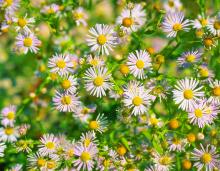Wildflowers, Grasses and Other Nonwoody Plants
Media

Species Types
Scientific Name
Ranunculus hispidus
Description
Hispid buttercup is a densely hairy plant with showy yellow flowers. It is found mostly in the southern half of Missouri, usually in moist locations.
Media

Species Types
Scientific Name
Boltonia decurrens
Description
A big river floodplain species, decurrent false aster has declined as wetlands have been drained and converted to agricultural crop production.
Media

Species Types
Scientific Name
Melilotus albus and M. officinale
Description
These two species of sweet clover are present all over America. Although they have been planted for forage, as bee plants, and as nitrogen-fixers, white and yellow sweet clover are now classified as invasive for their weediness and the problems they pose for natural habitats.
Media

Species Types
Scientific Name
Ranunculus fascicularis
Description
There are nearly 20 species in the genus Ranunculus in Missouri. Identify early buttercup by its early blooming time, its distinctively shaped, usually hairy leaves, and its preference for open woods, glades, or prairies.
Media

Species Types
Scientific Name
Pedicularis canadensis
Description
Wood betony has a tight spiral of tubular, hooded yellow flowers atop a plant adorned with deeply incised, fernlike leaves that are about as attractive as the flowers themselves. In early spring, these leaves have a beautiful wine-red coloration.
Media

Species Types
Scientific Name
Lespedeza cuneata
Description
Decades ago, sericea lespedeza was introduced in hopes it would provide hay, improve pastures, stop soil erosion, and supply food and cover for wildlife. Unfortunately, it has proven to be an aggressive, invasive weed that is extremely difficult to control, escapes cultivation, and outcompetes native plants.
Media

Species Types
Scientific Name
Solidago spp. (23 species in Missouri)
Description
There are 23 species of goldenrods in Missouri. They can be hard to identify to species, but as a group, the goldenrods are common and nearly unmistakable.
Media

Species Types
Scientific Name
Senna marilandica (formerly Cassia marilandica)
Description
The flowers of southern wild senna don’t look much like typical pea-family flowers, but its leaves and bean pods show the family resemblance. Look for it in moist situations, mostly south of the Missouri River.
Media

Species Types
Scientific Name
Dioscorea oppositifolia (sometimes called D. batatas)
Description
Similar to kudzu, Chinese yam is an aggressive vine that overtakes nearly everything within reach that stands still long enough! Learn more about this invasive plant — and please don’t plant it!
Media

Species Types
Scientific Name
Packera obovata (formerly Senecio obovatus)
Description
Most common in the Ozarks, round-leaved groundsel is one of seven Packera species in our state. Its showy, bright yellow, daisylike flowers form flat-topped clusters that arise from sparsely leaved stems.
See Also
About Wildflowers, Grasses and Other Nonwoody Plants in Missouri
A very simple way of thinking about the green world is to divide the vascular plants into two groups: woody and nonwoody (or herbaceous). But this is an artificial division; many plant families include some species that are woody and some that are not. The diversity of nonwoody vascular plants is staggering! Think of all the ferns, grasses, sedges, lilies, peas, sunflowers, nightshades, milkweeds, mustards, mints, and mallows — weeds and wildflowers — and many more!





















